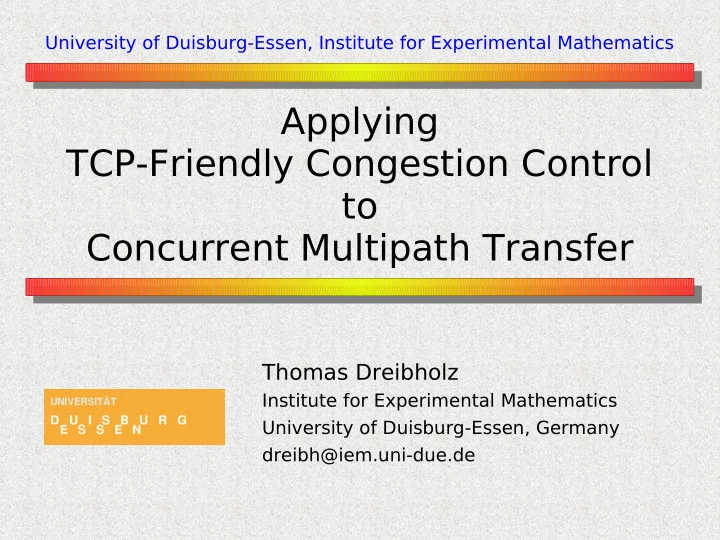

University of Duisburg-Essen, Institute for Experimental Mathematics Applying TCP-Friendly Congestion Control to Concurrent Multipath Transfer Thomas Dreibholz Institute for Experimental Mathematics University of Duisburg-Essen, Germany dreibh@iem.uni-due.de
Table of Contents Basics – SCTP and Concurrent Multipath Transfer (CMT) – CMT Fairness Problem – Resource Pooling (RP) Our Approach: CMT/RP-SCTP – Congestion Control – Simulation Scenario – Proof of Concept Conclusion and Outlook Thomas Dreibholz's SCTP Page Thomas Dreibholz's SCTP Page http://tdrwww.iem.uni-due.de/dreibholz/sctp/ http://tdrwww.iem.uni-due.de/dreibholz/sctp/ Applying TCP-Friendly Congestion Control to Concurrent Multipath Transfer Thomas Dreibholz P. 2
Stream Control Transmission Protocol (SCTP, RFC 4960) SCTP Features Transport-Layer Protocol (like TCP or UDP – but much more powerful!) – Reliable, message-oriented, ordered/unordered, multi-streaming – Multi-Homing Support for multiple addresses per endpoint; may be changed (“Add-IP”) – Multiple unidirectional paths in the network (can be disjoint or shared) – One path in each direction is chosen for user data ( primary path ) – Other paths: backup only (only used for retransmissions) – What about utilizing all paths simultaneously? What about utilizing all paths simultaneously? Applying TCP-Friendly Congestion Control to Concurrent Multipath Transfer Thomas Dreibholz P. 3
Concurrent Multipath Transfer (CMT) All paths are used for data transmission Assumption of CMT: paths are disjoint → congestion control Applying TCP-Friendly Congestion Control to Concurrent Multipath Transfer Thomas Dreibholz P. 4
CMT Fairness Problem Disjoint Paths Disjoint Paths Shared Bottleneck Shared Bottleneck CMT Congestion Control: TCP-like congestion control per path – CMT flow behaviour: – ● On path #1: like a single TCP flow ● On path #2: like a single TCP flow ● On shared bottleneck: like two TCP flows – Doubled bandwidth in comparison to single TCP flow => unfair – Cannot be detected reliably in arbitrary networks (e.g. the Internet) Applying TCP-Friendly Congestion Control to Concurrent Multipath Transfer Thomas Dreibholz P. 5
Resource Pooling (RP) Definition of Resource Pooling (RP) from [WHB09]: “Making a collection of resources behave like a single pooled resource” – Principle can be applied in many cases: – ● Statistical multiplexing ● Failure resilience ● … ● Load balancing Applying RP for multipath transfer: Do not handle each path independently – Instead, let the paths of a multi-homed flow behave like one big path … – … by using a congestion control which is aware of path interaction – Idea: combining CMT-SCTP with RP to solve the fairness problem! – How to realize a RP-enabled congestion control for CMT-SCTP? How to realize a RP-enabled congestion control for CMT-SCTP? Applying TCP-Friendly Congestion Control to Concurrent Multipath Transfer Thomas Dreibholz P. 6
CMT/RP-SCTP – Combining CMT-SCTP with RP Definitions: S = ∑ s i – the sum of slow start thresholds s i on path i – C = ∑ c i – the sum of congestion windows c i on path i – S P Idea: slow start threshold ratio as capacity measure for path P S Congestion window growth on path P Slow Start: on α acknowledged bytes in fully-utilized congestion window – c P = c P ⌈ min MTU P ,α ∗ S P S ⌉ Congestion Avoidance: on fully-acknowledged congestion window – c P = c P ⌈ MTU P ∗ S P S ⌉ Congestion window decrease on path P On Fast Retransmission: – 2 , 4 ∗ MTU P ∗ s P s P = max c P − C S , MTU P ;c P = s P On Timer-Based Retransmission: – 2 , 4 ∗ MTU P ∗ s P s P = max c P − C S , MTU P ;c P = MTU P Applying TCP-Friendly Congestion Control to Concurrent Multipath Transfer Thomas Dreibholz P. 7
Simulation Setup Scenario: Parameters: Routes switchable: disjoint paths or shared bottleneck – Saturated senders – Background flow(s): CMT-SCTP or CMT/RP-SCTP – Reference flow: non-CMT SCTP flow for comparison – ● Goal: this flow should get a fair bandwidth share, of course Applying TCP-Friendly Congestion Control to Concurrent Multipath Transfer Thomas Dreibholz P. 8
Throughput for Exclusive Usage of Two Disjoint 100 Mbit/s Paths Only One Flow Multiple Flows Only One Flow Multiple Flows CMT-SCTP CMT-SCTP CMT/RP-SCTP CMT/RP-SCTP Standard SCTP Standard SCTP Thoughput of single CMT/RP-SCTP flow is a little lower than CMT-SCTP … but no significant difference for multiple flows ... Applying TCP-Friendly Congestion Control to Concurrent Multipath Transfer Thomas Dreibholz P. 9
Congestion Window Examples CMT-SCTP CMT-SCTP Similar cwnd behaviour on both paths Similar cwnd behaviour on both paths CMT/RP-SCTP CMT/RP-SCTP Here: cwnd of path #2 grows slowly Here: cwnd of path #2 grows slowly Applying TCP-Friendly Congestion Control to Concurrent Multipath Transfer Thomas Dreibholz P. 10
Flow Concurrency in 100/100 Mbit/s Setup: Throughput of the Reference Flow Concurrency on Shared Bottleneck Concurrency on Disjoint Paths Concurrency on Shared Bottleneck Concurrency on Disjoint Paths CMT/RP-SCTP CMT/RP-SCTP CMT/RP-SCTP CMT/RP-SCTP Background Flow Background Flow Background Flow Background Flow CMT/RP-SCTP is working as expected! CMT/RP-SCTP is working as expected! CMT-SCTP CMT-SCTP CMT-SCTP CMT-SCTP Background Flow Background Flow Background Flow Background Flow Disjoint paths: CMT/RP flow takes less bandwidth on shared path Since it already gets 100% of the bandwidth on the non-shared path – Shared bottleneck: non-CMT flow gets 50% of the bandwidth Applying TCP-Friendly Congestion Control to Concurrent Multipath Transfer Thomas Dreibholz P. 11
Conclusion and Outlook Conclusion CMT-SCTP – Concurrent Multipath Transfer with SCTP – ● Unfair to concurrent non-CMT flows on shared bottlenecks Resource Pooling – ● Take care of congestion interaction among paths Our approach: CMT/RP-SCTP – CMT-SCTP with Resource Pooling – Proof of concept by simulations – Future Work Prototype implementation into FreeBSD networking stack – Performance for asymmetric paths – Contributions to IETF standardization process – Applying TCP-Friendly Congestion Control to Concurrent Multipath Transfer Thomas Dreibholz P. 12
Thank You for Your Attention! Any Questions? To be continued ... To be continued ... Visit Our Project Homepage: http://tdrwww.iem.uni-due.de/dreibholz/sctp Thomas Dreibholz, dreibh@iem.uni-due.de Applying TCP-Friendly Congestion Control to Concurrent Multipath Transfer Thomas Dreibholz P. 13
Recommend
More recommend